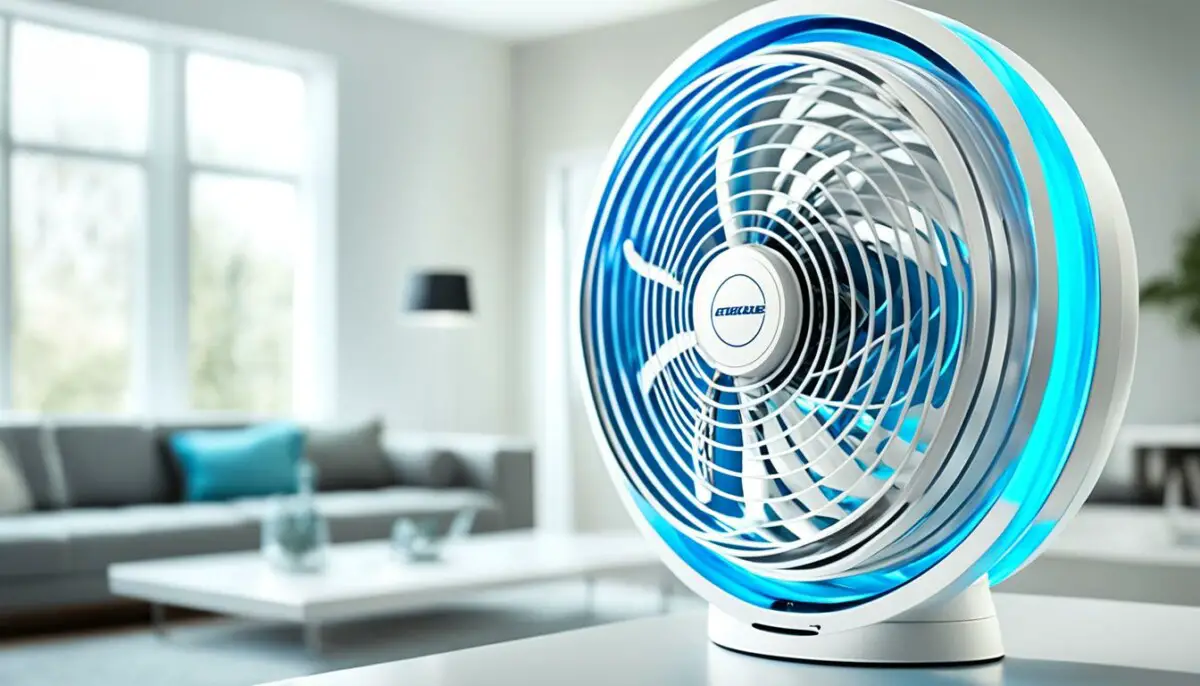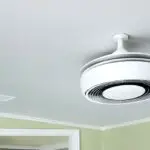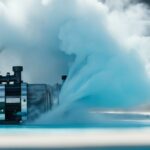Last Updated on 3 months by Francis
If you’ve ever wondered how bladeless fans work, you’re in the right place. Bladeless fans offer a modern and innovative approach to cooling, with their sleek design and efficient operation. Unlike conventional fans, bladeless fans don’t have visible blades, making them safer and easier to clean.
So, how do bladeless fans actually work? Bladeless fans utilize induction and entrainment to amplify airflow. They have a base with a mixed flow impeller that draws in air from all directions. The electric motor enclosed in a cover drives the impeller, creating a flow of air. The air is then pushed out through a slit in the discharge frame, creating a smooth and powerful airflow.
Induction occurs as the accelerated air mass exits the slit, creating a low-pressure ring that draws in ambient air. Entrainment happens as the accelerated air forms a swirling motion, causing more air to be drawn in from the surroundings. The combined effect of induction and entrainment amplifies the airflow by up to 15 times the amount that initially entered the impeller.
Bladeless fans are not only more efficient and quieter than traditional fans, but they also add a touch of elegance to any space. Their ability to concentrate or dissipate the flow of air makes them a practical and stylish cooling solution.
Contents
Key Takeaways:
- Bladeless fans operate by utilizing induction and entrainment to amplify airflow.
- They have no visible blades, making them safer and easier to clean.
- Induction occurs when the accelerated air creates a low-pressure ring that draws in more ambient air.
- Entrainment happens as the accelerated air forms a swirling motion, drawing in additional air from the surroundings.
- Bladeless fans offer a more efficient and quieter alternative to traditional fans while adding a stylish touch to any space.
What Are Bladeless Fans?
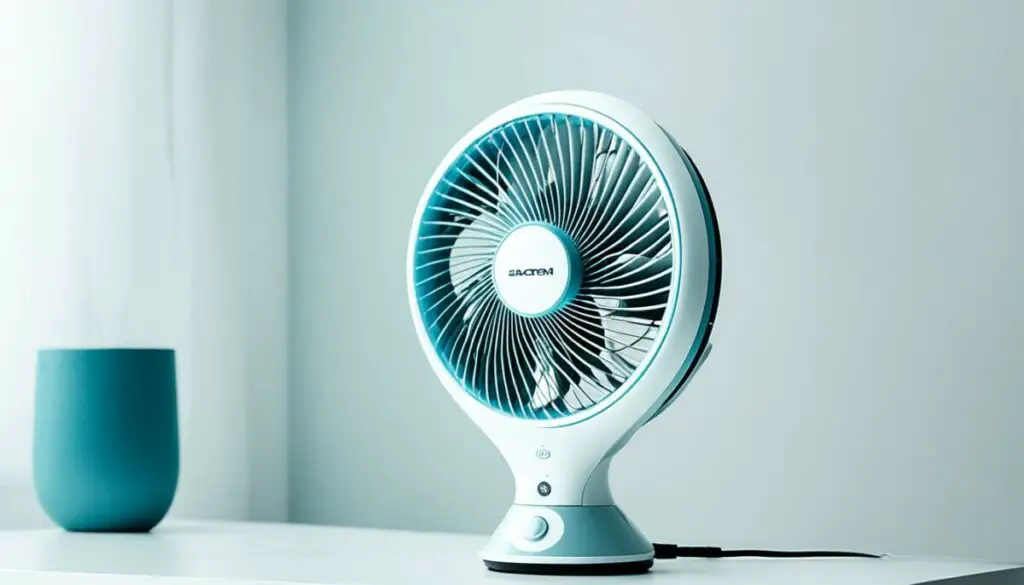
Bladeless fans are a revolutionary technology that has transformed the way we experience air circulation. Unlike traditional fans with visible rotating blades, bladeless fans employ cutting-edge bladeless fan technology to create a more powerful and aesthetically pleasing airflow.
The heart of a bladeless fan lies in its unique turbine, known as a mixed flow impeller. This impeller consists of asymmetrically arranged blades that draw in air from all directions. The fan is encased in a cover with strategically placed holes, allowing air to flow into it.
Once inside, the air is pushed out through a hollow cross-section that resembles an aircraft’s airfoil. This ingenious design creates a smooth and powerful airflow that is evenly distributed throughout the space, providing maximum comfort.
One of the key features of bladeless fans is that they act as air multipliers. Instead of relying solely on the air drawn into the impeller, bladeless fans leverage the phenomena of induction and entrainment to increase the volume of air passing through the fan.
“Bladeless fans are not just functional appliances; they are also ornamental and stylish.”
Induction occurs when the accelerated air exits the fan and creates a low-pressure ring, pulling in ambient air from its surroundings. Entrainment, on the other hand, refers to the swirling motion created by the accelerated air, which draws in even more air and amplifies the overall airflow.
This unique design and technology make bladeless fans more than just functional appliances; they are also ornamental and stylish. The sleek and modern appearance of bladeless fans adds a touch of elegance to any space.
In Summary:
- Bladeless fans concentrate or dissipate the flow of air in a given area.
- They utilize a special turbine called a mixed flow impeller.
- Air is drawn in from all directions and pushed out through a hollow cross-section.
- Bladeless fans act as air multipliers, utilizing induction and entrainment to increase airflow.
- They are not just functional, but also ornamental and stylish.
| Bladeless Fans | Conventional Fans |
|---|---|
| Unique and modern design | Traditional blade design |
| Smooth and powerful airflow | Disrupted airflow with rotating blades |
| Quiet operation | Audible noise from rotating blades |
| No exposed blades for safety | Risk of injuries from exposed blades |
| Easier to clean without blades | Blades require regular dusting |
| Energy-efficient technology | Higher energy consumption |
Bladeless Fan Working Principle
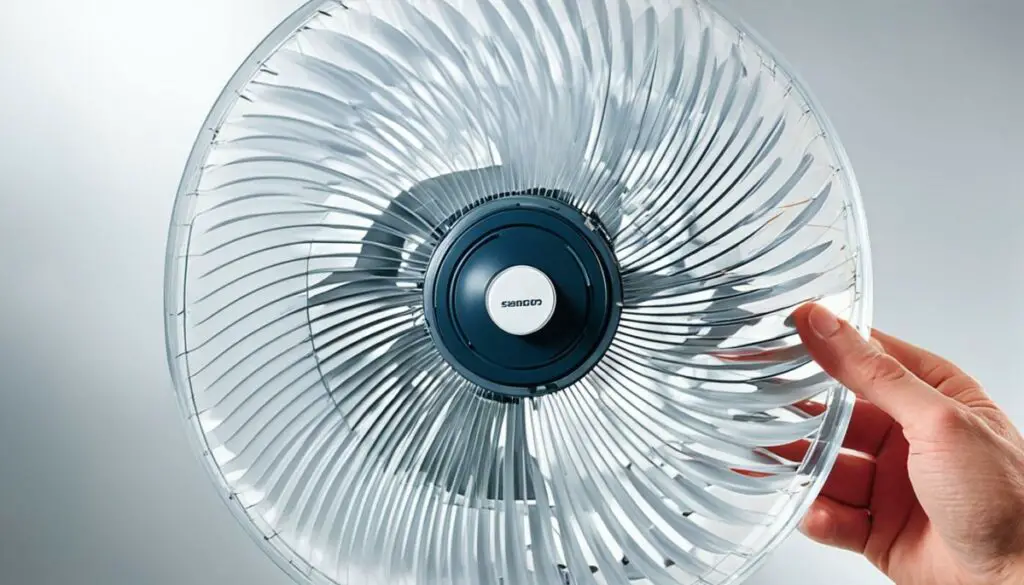
The working principle of a bladeless fan is based on fluid dynamics and the principles of Bernoulli’s theorem and the Coanda effect. Bernoulli’s theorem states that pressure and velocity are inversely related. When air enters the discharge frame of a bladeless fan, it accelerates outwards, causing a reduction in pressure. The ambient air in the discharge frame, which is at higher pressure, pushes the accelerated air towards the surface of the frame and follows its profile, resulting in the Coanda effect. This creates a ring of low pressure around the frame, which causes ambient air to enter the ‘hoop’ from one side and exit from the other, adding to the already accelerated air mass.
The air forced out of the fan forms an invisible boundary with the ambient air, and the turbulent motion in this boundary region causes more air to be drawn in through entrainment. Induction and entrainment work together to significantly amplify the airflow produced by the fan.
Now, let’s take a closer look at the working of a bladeless fan:
-
Inward Flow: The bladeless fan consists of a base with a mixed flow impeller that draws in ambient air from all directions. The impeller is driven by an electric motor enclosed in a cover with holes for air flow.
-
Acceleration and Pressure Reduction: As the impeller spins, it accelerates the air outwards, causing a reduction in pressure within the discharge frame.
-
Coanda Effect: The ambient air in the discharge frame, which is at higher pressure, follows the profile of the frame and pushes the accelerated air towards the surface. This results in the Coanda effect, creating a ring of low pressure around the frame.
-
Entrainment and Amplified Airflow: The low-pressure ring created by the Coanda effect allows ambient air to enter the ‘hoop’ from one side and exit from the other, adding to the already accelerated air mass. The turbulent motion in the boundary region between the accelerated air and ambient air causes more air to be drawn in through entrainment. The combined effect of induction and entrainment significantly amplifies the airflow produced by the fan.
Bladeless fans utilize the working principle described above to provide a powerful and smooth airflow without the need for visible rotating blades.
Image:
Bladeless Fan vs Traditional Fan
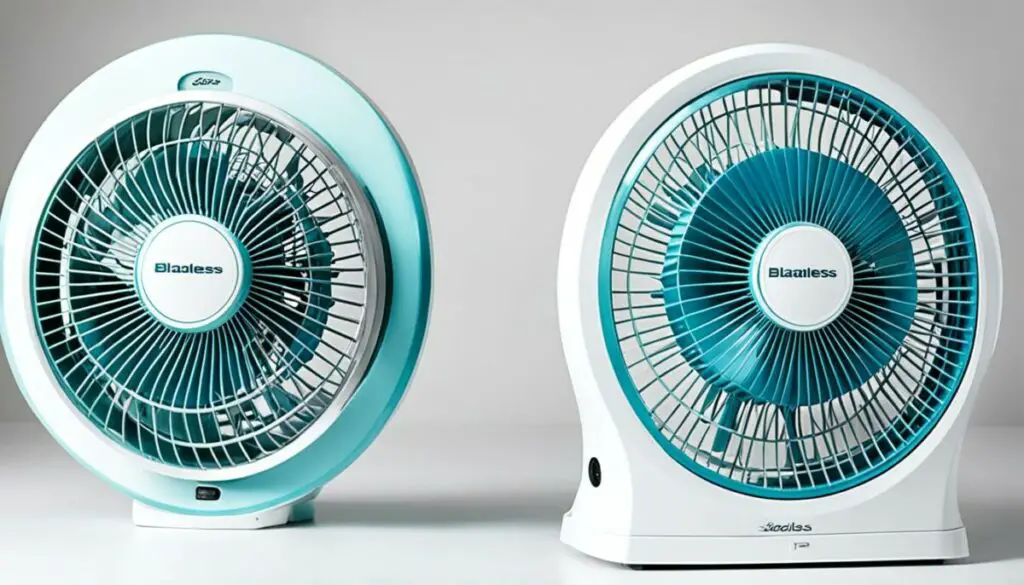
Bladeless fans offer several advantages over traditional fans. Firstly, they are safer because they do not have exposed rotating blades, making them suitable for households with children and pets. Additionally, the absence of blades makes bladeless fans easier to clean, as there are no blades to dust or wipe down. They are also more energy-efficient, thanks to the use of brushless DC motors, which consume less electricity. Bladeless fans are quieter in operation compared to traditional fans, creating a more peaceful environment. Their sleek and modern design blends seamlessly with any interior decor, while traditional fans may appear bulkier and less aesthetically pleasing. However, bladeless fans tend to be more expensive due to their high-precision design and engineering, as well as additional features like remote control and IoT operations.
| Bladeless Fan | Traditional Fan |
|---|---|
| Safer due to absence of rotating blades | Exposed rotating blades pose safety risks |
| Easier to clean without rotating blades | Dust and cleaning required for individual blades regularly |
| More energy-efficient with brushless DC motors | Higher energy consumption with conventional motors |
| Quieter operation for a peaceful environment | Produces more noise during operation |
| Sleek and modern design complements decor | Bulkier design may not be aesthetically pleasing |
| Higher cost due to precision engineering and additional features | Typically more affordable |
Overall, bladeless fans provide a safer, more energy-efficient, and aesthetically appealing cooling solution compared to traditional fans. While they may be a bit costlier, their benefits make them a popular choice for those looking for a modern and efficient way to stay cool.
Bladeless Fan Benefits
Bladeless fans offer a range of benefits that make them a preferred choice for many consumers. Firstly, their unique design and absence of visible moving parts make them safer for households with children and pets. The lack of exposed blades reduces the risk of accidents and injuries.
Additionally, bladeless fans are easier to clean as there are no blades to dust or wipe down. They also tend to be more energy-efficient compared to traditional fans, thanks to the use of brushless DC motors that consume less electricity.
Bladeless fans are known for their quiet operation, creating a more peaceful environment. Their sleek and modern design adds a touch of elegance to any space, making them a stylish addition to home decor.
Bladeless fans not only provide a safer cooling solution but also offer enhanced convenience and aesthetics.
Overall, bladeless fans provide a safer, more convenient, and aesthetically pleasing cooling solution.
| Bladeless Fans | Traditional Fans | |
|---|---|---|
| Safety | The absence of visible moving parts reduces the risk of accidents and injuries. | Exposed blades pose a potential hazard, especially for children and pets. |
| Cleaning | No blades to dust or wipe down, making cleaning easier and more convenient. | Blades require frequent dusting and cleaning. |
| Energy Efficiency | Brushless DC motors consume less electricity, resulting in higher energy efficiency. | Traditional fans with blades consume more electricity. |
| Noise Level | Bladeless fans produce minimal noise, creating a more peaceful environment. | Traditional fans can produce significant noise levels. |
| Design | Sleek and modern design adds an aesthetic appeal to any space. | Traditional fans may appear bulkier and less aesthetically pleasing. |
Bladeless Fan Technology in Ceiling Fans
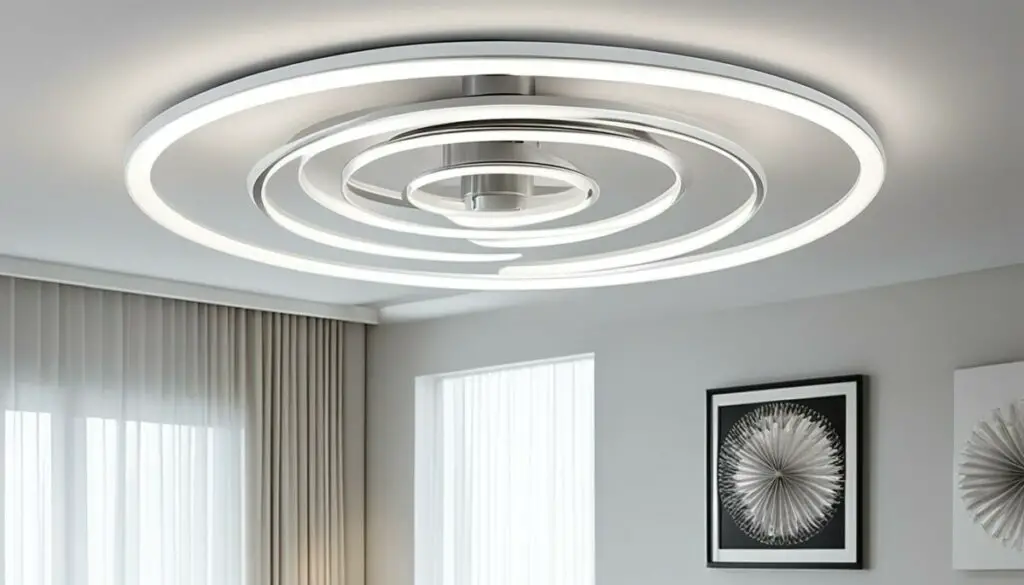
Bladeless fan technology has also been implemented in ceiling fans, offering the same benefits as bladeless table fans. Bladeless ceiling fans have a hollow air duct that sucks in air and propels it out at high speeds, creating a strong cooling airflow. Inside the fan’s body is a brushless DC motor with an impeller that generates the powerful air jet. However, on the outside, bladeless ceiling fans have a sleek and futuristic design without any visible rotating blades. This design not only enhances the safety of ceiling fans, particularly in rooms with low ceilings or where children are present, but also simplifies the cleaning process. The smooth surface of bladeless ceiling fans allows for easy dusting with just a wipe, eliminating the need to clean individual blades. Furthermore, bladeless ceiling fans are energy-efficient, produce minimal noise, and have a long lifespan, making them a practical and stylish choice for cooling homes.
| Advantages of Bladeless Ceiling Fans |
|---|
| Enhanced safety with no exposed rotating blades |
| Easy cleaning with a smooth surface |
| Energy-efficient operation |
| Quiet performance |
| Sleek and modern design |
| Long lifespan |
Bladeless Fans and Wind Turbines
The concept of bladeless fans has also inspired innovation in wind turbine technology. Bladeless wind turbines aim to address the spatial requirements, environmental impact, and efficiency issues associated with traditional wind turbines.
By harnessing the phenomenon of vortex shedding, bladeless wind turbines offer a safer, more efficient, and wildlife-friendly alternative. These turbines oscillate in the wind, capturing energy from the fluid motion and generating power through the creation of vortices. This design not only improves efficiency but also reduces noise and vibration.
“Bladeless wind turbines have the potential to revolutionize the wind energy industry, offering a more sustainable and environmentally conscious approach to electricity generation.”
The unique mechanism of bladeless wind turbines allows for an increase in the airflow, resulting in better productivity and output. This is achieved by eliminating the traditional rotor blades and implementing a bladeless design that utilizes the principles of fluid dynamics. The airflow is amplified through oscillatory movements of the turbine, creating vortices that efficiently capture the wind energy.
Compared to traditional wind turbines, bladeless wind turbines offer several advantages. They have a smaller footprint, making them suitable for installation in urban environments where space is limited. They also have a reduced impact on wildlife, as the absence of rotating blades eliminates the risk of bird and bat collisions.
Additionally, bladeless wind turbines are less susceptible to damage from high winds and storms, as they have fewer mechanical components that can be affected. This leads to lower maintenance costs and increased reliability.
Bladeless wind turbines have the potential to contribute significantly to the renewable energy sector and address the growing demand for clean energy sources. Their innovative design and enhanced efficiency make them a viable option for electricity generation in various settings, from residential areas to large-scale wind farms.
Comparison of Bladeless Wind Turbines and Traditional Wind Turbines
| Aspect | Bladeless Wind Turbines | Traditional Wind Turbines |
|---|---|---|
| Eco-friendliness | Reduce wildlife impact | Potential bird and bat collisions |
| Efficiency | Vortex shedding amplifies airflow | Rotating blades generate lift |
| Space Requirements | Smaller footprint, suitable for urban areas | Larger area needed for rotor blades |
| Maintenance | Reduced mechanical components, lower maintenance | Complex mechanical system, higher maintenance |
Bladeless wind turbines offer a safer, more efficient, and eco-friendly alternative to traditional wind turbines. Their unique mechanism harnesses the power of vortices to generate electricity, resulting in better performance and reduced environmental impact.
The Future of Bladeless Fans and Wind Energy
While bladeless fans have already made a significant impact as stylish and efficient cooling devices in the consumer market, their potential in the field of wind energy is still being explored. Researchers are actively fine-tuning the design and studying the performance of bladeless wind turbines, which hold great promise for a greener and more sustainable future.
Bladeless wind turbines offer several benefits that can reshape the landscape of wind energy. One key advantage is their reduced material requirements and compact size, making them suitable for installation in urban environments where traditional turbines may face spatial constraints. By utilizing bladeless fan mechanism technology, these innovative turbines provide a safer and more environmentally friendly solution for harnessing wind power.
“The reduced material requirements and compact size of bladeless wind turbines make them suitable for installation in urban environments, where traditional turbines may face spatial constraints.”
Bladeless wind turbines operate on principles similar to bladeless fans, leveraging the airflow amplification mechanism achieved through induction and entrainment. These turbines oscillate in the wind and generate power by creating vortices, resulting in improved efficiency, reduced noise, and vibration compared to traditional wind turbines.
The application of bladeless fan technology in wind energy has the potential to revolutionize electricity generation, offering a greener and cleaner alternative to conventional methods. As research and development efforts continue, the future of bladeless fans and wind energy aims to create a more sustainable world powered by innovative and efficient technologies.
Conclusion
Bladeless fans offer an innovative and efficient alternative to traditional fans, thanks to their unique design and working principle. By leveraging the induction and entrainment phenomena, bladeless fans are quieter and more energy-efficient than their traditional counterparts. Their sleek and modern design adds a touch of elegance to any space, making them a stylish choice for cooling.
Bladeless fan technology has also extended to ceiling fans, providing the same benefits with the added convenience of easy cleaning. With no exposed blades, bladeless ceiling fans enhance safety and simplify maintenance. Moreover, the concept of bladeless fans has inspired the development of bladeless wind turbines, which could revolutionize the wind energy industry. These turbines offer a safer, more efficient, and wildlife-friendly solution, addressing challenges such as spatial requirements and environmental impact.
The future of bladeless fans and wind energy looks promising, paving the way for a greener and cleaner future of electricity generation. As bladeless fan technology continues to evolve, consumers can expect more advancements in air multiplier capabilities, improved working principles, and sleeker designs. With their numerous benefits and potential for energy savings, bladeless fans are poised to become an integral part of modern cooling solutions in homes, offices, and other spaces.
FAQ
How does a bladeless fan work?
Bladeless fans utilize induction and entrainment phenomena to amplify air flow. They draw in ambient air from all directions using a mixed flow impeller and then accelerate the air out through a slit in the discharge frame. This creates a low-pressure ring that draws in even more ambient air, resulting in a significant increase in airflow.
What are bladeless fans?
Bladeless fans are cooling devices that do not have visible rotating blades like traditional fans. They consist of a base with a mixed flow impeller, enclosed by a cover with holes for air flow. The air is then propelled out through a hollow cross-section, creating a smooth and powerful airflow. Bladeless fans are also known as air multipliers due to their ability to amplify the airflow without actually drawing that air into the impeller.
What is the working principle of a bladeless fan?
Bladeless fans operate based on fluid dynamics and the principles of Bernoulli’s theorem and the Coanda effect. When air enters the discharge frame, it accelerates outwards, creating a reduction in pressure. The ambient air at higher pressure pushes the accelerated air towards the frame’s surface, resulting in the Coanda effect. This forms a ring of low pressure that draws in additional ambient air, significantly increasing the airflow.
How does a bladeless fan compare to a traditional fan?
Bladeless fans offer several advantages over traditional fans. They are safer due to the absence of exposed rotating blades, making them suitable for households with children and pets. Bladeless fans are also easier to clean as there are no blades to dust or wipe down. They tend to be more energy-efficient, quieter in operation, and have a sleek and modern design that enhances any interior decor.
What are the benefits of using a bladeless fan?
Bladeless fans provide several advantages. They are safer, easier to clean, more energy-efficient, and produce less noise compared to traditional fans. Their sleek and modern design adds a touch of elegance to any space. Additionally, bladeless fans offer a powerful and amplified airflow due to their induction and entrainment technology.
How does bladeless fan technology apply to ceiling fans?
Bladeless fan technology has been implemented in ceiling fans, providing the same benefits as bladeless table fans. The hollow air duct in bladeless ceiling fans sucks in air and propels it out at high speeds, creating a strong cooling airflow. These fans have a sleek and futuristic design without any visible rotating blades, enhancing safety and simplifying the cleaning process.
Bladeless fan technology has inspired innovation in wind turbine design. Bladeless wind turbines utilize vortex shedding to capture energy from fluid motion and generate power through the creation of vortices. This design offers a safer, more efficient, and wildlife-friendly alternative to traditional wind turbines, addressing spatial constraints, environmental impact, noise, and vibration.
What does the future hold for bladeless fans and wind energy?
Bladeless fans and wind turbines have promising prospects for shaping the future of cooling and electricity generation. Bladeless fans will continue to provide innovative and efficient cooling solutions, while bladeless wind turbines offer a greener and cleaner alternative to traditional methods of wind energy generation. Ongoing research and development aim to fine-tune their design, performance, and application in various settings.
Source Links
- https://www.scienceabc.com/pure-sciences/are-bladeless-fans-really-bladeless-how-do-they-work.html
- https://www.linkedin.com/pulse/bladeless-ceiling-fan-india-rakesh-sharma-cxkkc?trk=article-ssr-frontend-pulse_more-articles_related-content-card
- https://medium.com/@miteefire/harmony-in-motion-unveiling-the-bladeless-fan-a-paradigm-shift-in-wind-turbine-innovation-4788270eaa06

